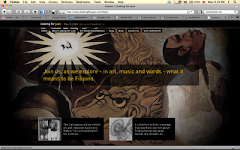Monday, July 26, 2010
Winners Announced!
No categories, just Best Reads for 2010.
Araw sa Palengke (Market Day)
Written by May Tobias-Papa
Illustrated by Isabel Roxas
Adarna, 2008
(In Filipino, with English translations)
Can We Live on Mars?: A Book About Space
Written by Gidget Roceles-Jimenez
Illustrated by Bru
Adarna, 2009
(In English)
Just Add Dirt
Written by Becky Bravo
Illustrated by Jason Moss
Adarna, 2009
(In English, with Filipino translations)
Lub-Dub, Lub-Dub
Written by Russell Molina
Illustrated by Jomike Tejido
Bookmark, 2008
(In English)
Tagu-Taguan (Hide-and-Seek): A Counting Book in Filipino
Written and illustrated by Jomike Tejido
Tahanan, 2009
(In Filipino, with English translations)
Tuwing Sabado (Every Saturday)
Written by Russell Molina
Illustrated by Sergio Bumatay III
Lampara, 2009
(In Filipino, with English translations)
In the words of the Philippine Board on Books for Young People (PBBY) Treasurer Rayvi Sunico, "The National Children's Book Award: Best Reads for 2010 aspires to be a different type of literary 'contest.' It consciously avoids rankings because it believes that each work of art and culture is an individual, incomparable achievement and cannot be compared the way commodities can be compared.
"Unlike other competitions, its focus is on the BOOK, that is to say, a cultural but also physical object that is the product of teamwork, from author and/or illustrator, to the editor, publisher, and the printer."
We are happy to have been part of and witness to the first NCBA. Congratulations to all the winners and to the National Book Development Board (NBDB) and PBBY for organizing.
Wednesday, July 21, 2010
Juan Sajid Imao's Open Endings
 Juan Sajid Imao, multi-awarded sculptor, represents a story with each artwork that he creates. This is particularly true for his latest collection, Open Endings. Each piece symbolizes a personal experience that he believes has made his life more meaningful and contributed greatly to his personal transcendence.
Juan Sajid Imao, multi-awarded sculptor, represents a story with each artwork that he creates. This is particularly true for his latest collection, Open Endings. Each piece symbolizes a personal experience that he believes has made his life more meaningful and contributed greatly to his personal transcendence.With his work, Imao parlays the unlocking of these experiences. It is with fascination that he involves his viewers in this process as he likes to think that his sculptural stories are open-ended, thus giving them the luxury of making their own narratives.
It is the artist’s hope that those who will see his sculptures would be encouraged to reflect on their own lives. “I want viewers to interact with my works and maybe help them realize that there really is an open ending to any experience.”
Age-old superstitions and long-held beliefs, known to Filipinos as “pamahiin,” are also rendered in some of Sajid’s pieces. For instance, he was inspired by the proverb “Matutong mamaluktot” which means that one has to learn to curl up or fit under any blanket no matter how small. The euphemism for a person’s need to adapt to a situation especially during tough times is depicted with nuance in “Namamaluktot.” The same piece shall be featured at 1/of Gallery’s showcase in the upcoming ManilArt exposition.
Open Endings is on its second leg at 1/of Gallery, 2nd level, Shops at Serendra, Bonifacio Global City and is co-presented by Project Art.
A portion of the exhibit proceeds will benefit the Resources for the Blind Foundation, Inc.
Sunday, July 18, 2010
Art, Ideas and Sex
THE IMAGINATION CHALLENGE
It says something about the social development role of art, design and technology. That with some imagination, and imaginative use of the tools that we already have like the internet and other tools of technology, we might actually have it in and around us to deal with many of the problems we face now, especially as a nation. And we're talking about the big things like education and poverty and corruption and transparency and progress.
It's something to think about. It's something we think about.
Friday, July 16, 2010
We publish stories.
To paraphrase Chimamanda Adichie, Nigerian novelist, there is a danger to the single story because it assumes that there is only one story, one vantage point, one truth; when in fact, there are many. She speaks of this at length in her TED Talk below.
We publish stories. We have published nine so far.
In these stories live varied characters –
.jpg)
There is Mang Tomas, the town’s well-loved jeepney driver who, with his trusty jeep, is witness to life in Barangay Pastol – each child’s baptism, each couple’s walk down the aisle, and each student’s graduation from school. Through his humble trade, he provides for his family and dreams of sending them all through school.
There is Lupito, a young traveling salesman who lands in a circus village. At first a stranger and transient, he decides to make Barrio Sirkero his home after he falls for the town beauty with a telekinetic gift, Sela, and n keeping with the barrios’ customs of courtship, he wins her heart through paninilbihan and panunuyo.

There is Romeong Mapangarapin who, according to doctors’ diagnosis, would not amount to much, yet whose imagination and creativity could not be crippled. In his mind, he is a poet and a traveler, two perfect things to be.
We are happy to participate in the act of story-telling. With nearly all our stories published in both Filipino and English, the invitation to read extends to non-Filipino speakers.
It is our hope that each of our stories help to reveal another layer of the Filipino, celebrating our truths or imagination.
It is good to not have a singular narrative. There should never be just one story to tell.




